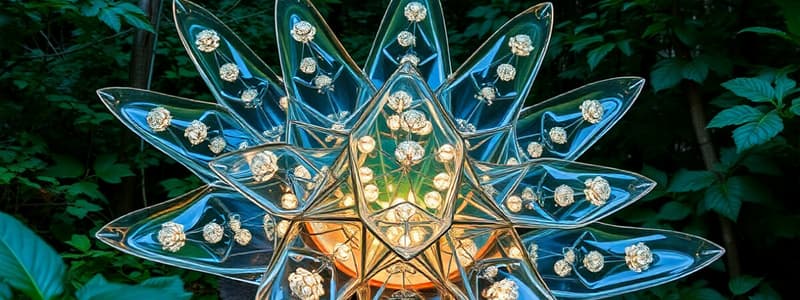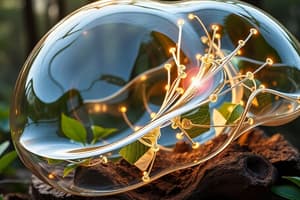Podcast
Questions and Answers
What is a significant benefit of self-cleaning surfaces inspired by lotus leaves?
What is a significant benefit of self-cleaning surfaces inspired by lotus leaves?
- Lower durability compared to regular surfaces
- Reduced maintenance and less reliance on harmful cleaning chemicals (correct)
- Increased maintenance costs
- Higher reliance on cleaning chemicals
Which architectural design is influenced by termite mounds to achieve energy efficiency?
Which architectural design is influenced by termite mounds to achieve energy efficiency?
- The Louvre Pyramid
- The Guggenheim Museum
- The Eastgate Centre in Zimbabwe (correct)
- The Sydney Opera House
How do artists incorporate biomimicry into their patterns and forms?
How do artists incorporate biomimicry into their patterns and forms?
- By focusing only on geometric patterns
- By avoiding natural shapes
- By mimicking fractals or symmetrical structures found in nature (correct)
- By creating solely abstract designs
What natural function inspired the design of Velcro?
What natural function inspired the design of Velcro?
What approach are urban planners using to promote biodiversity through biomimicry?
What approach are urban planners using to promote biodiversity through biomimicry?
What does the structural design of bird bones provide for furniture design?
What does the structural design of bird bones provide for furniture design?
Which feature is observed in robotics influenced by biomimicry?
Which feature is observed in robotics influenced by biomimicry?
How can LED lighting systems enhance interior environments through biomimicry?
How can LED lighting systems enhance interior environments through biomimicry?
Flashcards are hidden until you start studying
Study Notes
Biomimicry in Art and Design
- Biomimicry draws inspiration from nature to address human challenges through innovative designs and solutions.
- Key applications include material innovation, structural design, pattern and form, functionality, ecosystem integration, furniture design, robotics, and lighting.
Material Innovation
- Artists and designers analyze natural materials to create sustainable alternatives that emulate properties like strength and water resistance.
- Example: Self-cleaning surfaces modeled after lotus leaves reduce the need for harsh cleaning chemicals.
Structural Design
- Architectural designs often mimic natural structures for efficiency.
- Example: Eastgate Centre in Zimbabwe uses termite mounds' design to naturally regulate temperature and air flow, reducing energy costs.
Pattern and Form
- Aesthetic designs frequently mimic natural patterns, such as the fractal shapes in leaves or shell symmetry.
- This mimicking extends to textiles, where fish scale structures inspire lightweight, durable fabrics.
Functionality
- Innovative products are based on natural functions, like Velcro, which imitates how burrs cling to animal fur.
- Solar panels are designed to optimize sunlight capture by emulating leaf functions.
Ecosystem Integration
- Urban planners employ biomimetic principles to develop green corridors that reflect natural habitats, enhancing biodiversity and air quality.
Furniture Design
- Design inspiration from bird bone structures results in lightweight yet strong and durable furniture, facilitating ease of movement.
Robotics
- Engineers create robots that replicate the movements of animals; for instance, robotic arms mimic octopuses' dexterity for complex object manipulation.
Lighting
- LED lighting systems are designed to replicate natural light patterns, improving energy efficiency and promoting healthier indoor environments.
Conclusion
- Biomimicry fosters creativity and sustainable practices across diverse fields, leading to innovative and visually appealing solutions that benefit both functionality and the environment.
Studying That Suits You
Use AI to generate personalized quizzes and flashcards to suit your learning preferences.




